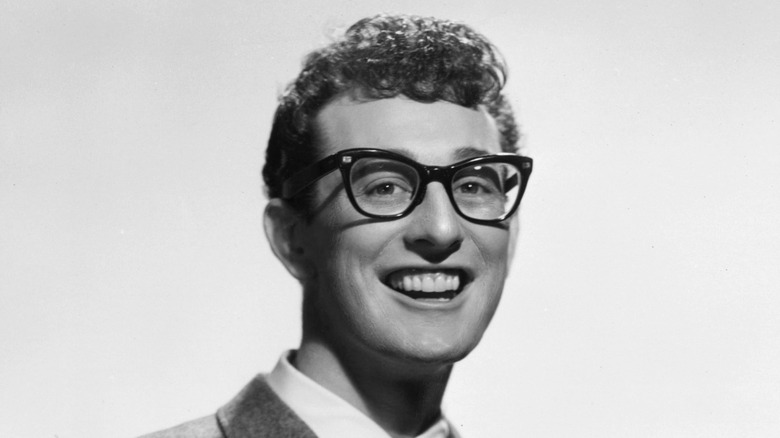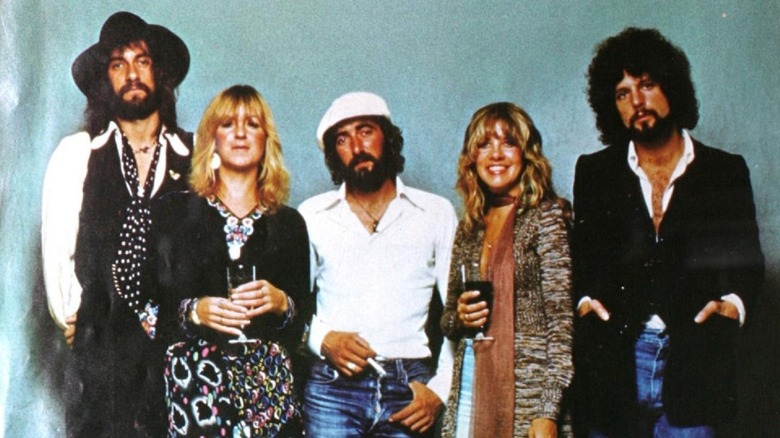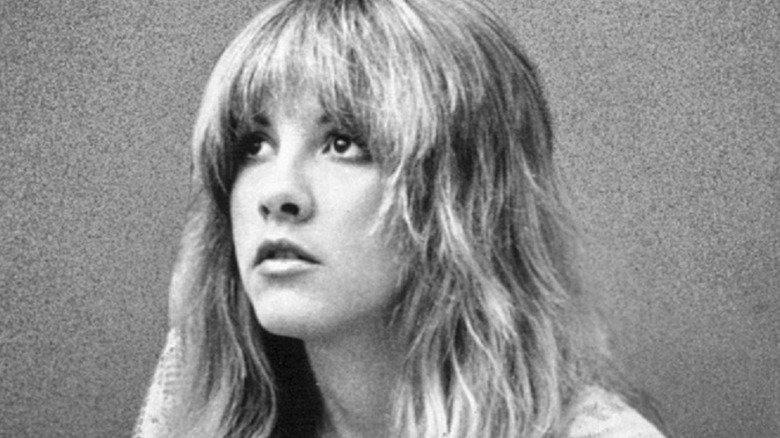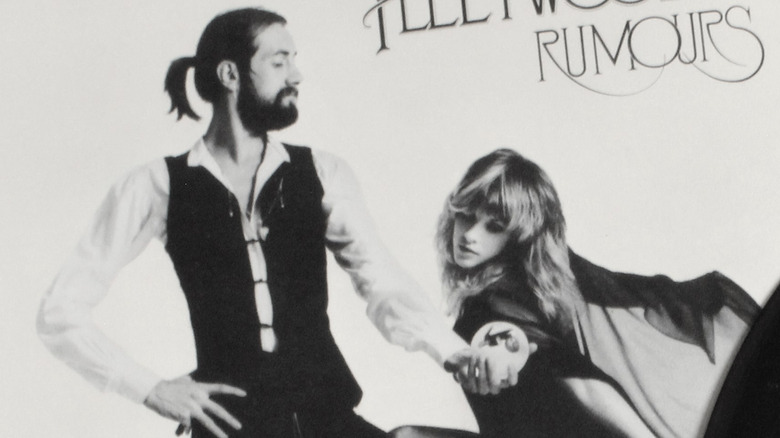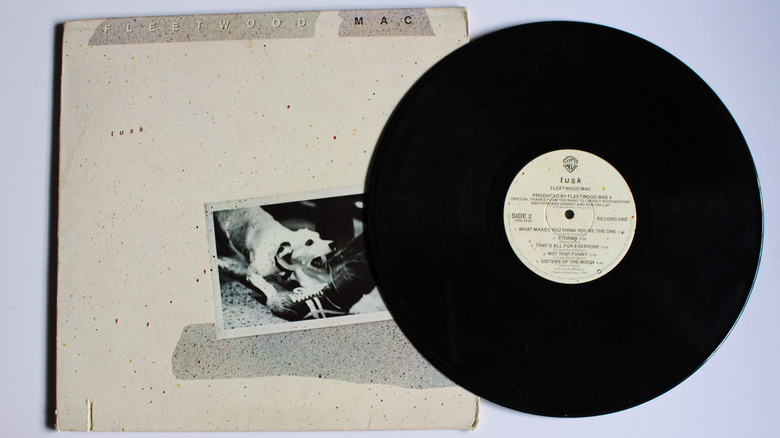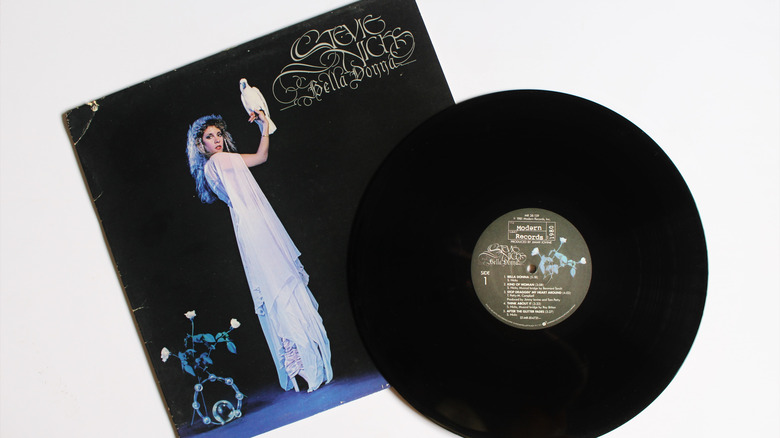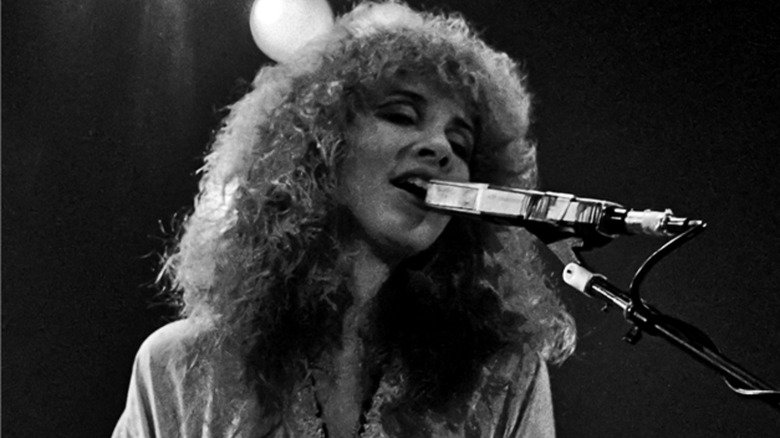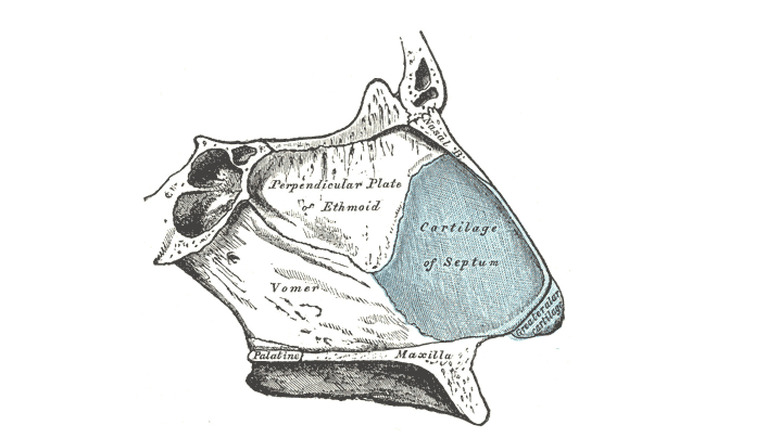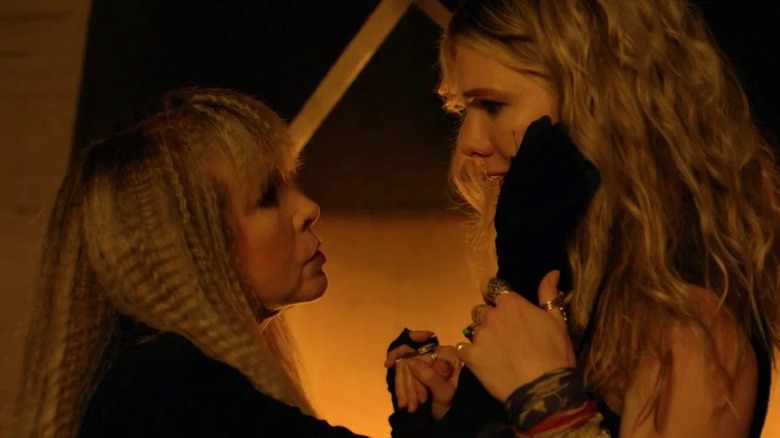The Untold Truth Of Stevie Nicks
Stevie Nicks has always come across as a little otherworldly. Put it down to the flowing black outfits, the songs about magical and elusive women, and the voice that can sound like either a warning or an invitation from a different realm. While Nicks is proud of her spiritual side (including connections to some pretty famous people who have crossed over), she's also lived a very human life, filled with mistakes, loss and heartbreak, as well as hard work and meteoric success.
Nicks knew that she wanted to be a songwriter from a young age, but it took a decade before her musical abilities first found a big audience as part of Fleetwood Mac. The British-born folk rock band had been through its own dramatic history by then. But it was when Nicks and her then-boyfriend Lindsey Buckingham signed on that they found their groove.
Fame proved to be a double-edged sword, bringing with it scrutiny of her appearance, tensions with Buckingham, and a serious cocaine addiction. Nicks would probably be the first to say that she's never been perfect. But beneath the lace and the faraway look is a will to survive, to dance with joy or grief, and, above all, to give other people music that might help them do the same.
Stevie Nicks was introduced to music by her grandfather
Stevie Nicks wasn't the only gifted musician in her family. Her paternal grandfather, Aaron Jess Nicks, was an aspiring country singer. He spotted his granddaughter's musical abilities when she was a little girl.
Stevie told Vogue that Aaron introduced her to old records by the likes of Buddy Holly and the Everly Brothers. He also taught her to play guitar and sing country tunes. He even gave 4-year-old Stevie her first taste of performing in front of a crowd. She would dress up as a mini cowgirl, and he would take her to sing classic country duets like "Darling Clementine" with him in various saloons.
However, Stevie says that her love of performing on a stage stemmed from a different kind of skill. When she was in the sixth grade, she performed a tap dance with a friend for a talent show. The applause from the crowd proved to her that she wanted to entertain people for a living.
It was at roughly the same age that Stevie abandoned country for R&B and rock 'n' roll. But something of the style stuck with her. She once told an interviewer that she had to force herself not to sing in a country style, because, "My roots are straight out of country ... It's because my grandad sang country music to me almost my whole life."
She first met Lindsey Buckingham at a religious youth meeting
Stevie Nicks and her family moved frequently during her early life for her dad's corporate career. She was born in Arizona and lived in New Mexico, Texas, and Utah before settling in California during her teens. It was there that she met Lindsey Buckingham, the man who would become her first big love, her creative partner, and occasionally an adversary.
Nicks says that she and Buckingham met in 1966, at a meeting of a religious youth group called Young Life, which she saw as a way to get "out of the house on a Wednesday night." She was a high school senior — and already knew she wanted to be songwriter, according to the Guardian — and Buckingham was a year younger. That night, they played "California Dreamin'" by the Mamas and Papas together.
Although Nicks claims that she was "captivated" by Buckingham from the start, that was their first and last meeting until two years later. At that point, Nicks had dropped out of San Jose State College, when she got a call from Buckingham, asking if she wanted to join a San Francisco folk group called Fritz.
The band became quite successful locally, opening for Jimi Hendrix, CCR, Santana, and Nicks' musical heroines, Janis Joplin, and Grace Slick with Jefferson Airplane. Despite this, Fritz broke up in 1971. At some point, Nicks and Buckingham became a couple and started to make their own music, under the moniker Buckingham Nicks.
Fleetwood Mac called just in time
Shortly after the demise of Fritz, the duo now known as Buckingham Nicks had written enough material to record an album. They were signed to Polydor, but their self-titled debut was a flop and the label dropped them. Undeterred, they continued to work on new songs, including future Fleetwood Mac hits "Monday Morning," "Rhiannon," and "Landslide."
Stevie Nicks was also working as a cleaner and a waitress to support the couple financially. She enjoyed the waitressing job, working lunches so she could go home and write music with Lindsey Buckingham in the evenings. As for Buckingham, Nicks said he quit a telemarketing job the first time someone hung up on him.
However, by October of 1974, Nicks was under pressure to find a more stable career. Around that time, she promised her worried father — who just had open heart surgery — that she would give her musical aspirations three more months, and if nothing came of it by January, she'd give up.
On New Year's Eve, Fleetwood Mac called Buckingham and invited him to join them on guitar — their seventh guitarist in as many years. Buckingham refused to come without Nicks. After the band met, singer Christine McVie was allowed the final say over adding another woman to the ensemble. Fortunately, "I liked her instantly," McVie later told the Guardian.
Even Stevie Nicks has felt insecure about her looks
Although Stevie Nicks has long been considered a folk rock pin-up star, she's admitted to feeling insecure about her appearance.
In 1975, Fleetwood Mac released the self-titled album that scored them their first big break. Suddenly, Nicks found herself subject to comments about her looks. In response, the following year, she got silicone breast implants, later explaining, "I had always thought my hips were too big and that I had no chest." She also later tried Botox but told the Guardian she thought it made her look like a member of "a satanic cult. ... it destroyed my face for four months."
In 1994, Nicks realized that the implants were making her feel fatigued and had them removed. "It turned out they were totally broken," she told People. Nicks also said that she nearly quit singing — "the love of my life" — that year, because she was so sick of "people talking about how fat I was." She's also told Rita Braver that the reason she wears black is "because we look thin in black."
In the same interview, Nicks described her hair during the '70s and '80s as "horrible." She prefers her natural straight hair but used to get it permed because it was easier to manage. Which meant, in Nicks' view, that she was always veering between the perm, which she didn't like; the growing-out perm, which was even worse; and straight hair that she liked but was too much work.
Stevie Nicks had a short-lived love affair with Mick Fleetwood
Stevie Nicks' and Buckingham's romantic relationship ended while the new line-up was working on their second album together, "Rumours," in 1976. Nicks told the Oprah Winfrey Network that they "had a very bad fight" and she called the relationship off. They both decided to stay in the band, but doing press for the album stirred some surprising feelings.
At a shoot for the cover of Rolling Stone, the whole band was photographed lying on a bed together. Buckingham paired with Christine McVie — in the process of divorcing bassist John McVie, who lay alone in the photo — and Nicks was with drummer Mick Fleetwood, who was also getting divorced.
The photo sparked a mini-reunion with Nicks and Buckingham, and newly discovered chemistry between Nicks and Fleetwood spilled over into an affair a year later. By then, Fleetwood Mac was on tour, and Nicks was dating Don Henley from the Eagles, although the couple rarely saw each other.
Nicks later blamed heavy cocaine use, recalling that she and Fleetwood got together after being "the last two people at the party." But she added that it was, "a doomed thing, caused a lot of pain ... led to nothing." Fleetwood had a slightly more optimistic take. He told Salon, "me and Stevie ... had a moment in time when ... we were in love. It was never to be that it could grow and be allowed to breathe in the open."
Having an abortion gave Stevie Nicks the chance to keep making music
By 1979, Stevie Nicks was still in a relationship with the Eagles' Don Henley, and Fleetwood Mac were working on their follow-up to "Rumours" — "Tusk" — which came out that October. Some time that year, Nicks discovered she was pregnant and had an abortion. Abortion had been legal for six years by then: The 1973 Supreme Court case "Roe v. Wade" had ruled that state restrictions that placed an "undue burden" on pregnant people seeking abortions were unconstitutional.
Nicks stands by her choice and other people's right to choose to terminate a pregnancy. She told the Guardian that becoming a mother would have meant she'd have had to quit the band. "There's just no way that I could have had a child then, working as hard as we worked," Nicks said. She also pointed to her heavy drug use as creating a less-than-ideal environment for a child.
In addition to not wanting to lose her career, Nicks says she believed that the music she could go on to make with Fleetwood Mac was "going to heal so many people's hearts." She also wanted the world to have a top band with two female lead singers and writers.
Henley was apparently less impressed. He tried to claim that Nicks wrote the song "Sara" about the aborted fetus. Nicks has rejected this, explaining that the name "Sara" was a reference to her friend Sara Recor, whom Mick Fleetwood eventually married.
Stevie Nicks is as famous for her solo career
Although Fleetwood Mac had overcome broken hearts and deep-seated hurt to make "Rumours," which became a massive success, it was "Tusk" that temporarily split up the band. The album was considered a commercial flop, and the year-long world tour Fleetwood Mac went on to support it only furthered cocaine-fueled tensions.
According to the Saturday Evening Post, Stevie Nicks had been making demos of songs she was writing during the recording sessions for "Tusk." In 1980, she decided she would finish them without the rest of Fleetwood Mac. She also co-founded independent record label Modern Records to put out her music. Her debut solo album, "Bella Donna," was released on July 27, 1981, and hit number one in the Billboard albums chart on September 4. It stayed in the Top 200 for almost three years.
Nicks was proud, but she later reflected that her success caused tension with many of the men in her life. When she gave Lindsey Buckingham a copy, he left it on the floor of the studio. Nicks told the Guardian, "They were full-on jealous ... all of them. They hated that kind of confidence in a woman." She said that shortly after the album came out, even her father told her she wouldn't ever find a man who would marry such a successful woman.
Plenty of people love Nicks' music, however. As of 2021, she's released eight solo studio albums and two live albums, selling over 30 million copies.
Steve Nicks' marriage was built on tragedy
Stevie Nicks never married either of her two most famous boyfriends, Lindsey Buckingham and Don Henley. But she did have a brief marriage, which started and ended in 1983, born from a tragedy in her personal life.
Nicks met Robin Snyder when she was 14 or 15, at Arcadia High School. Nicks said of her best friend, "She was the one person that knew me for the person I really was." Around 1981, Snyder was diagnosed with leukemia. She briefly went into remission and got pregnant: the father was her husband Kim Anderson. Then the cancer returned. Nicks told the Oprah Winfrey Network that Snyder chose not to get further treatment, because she knew she was going to die, and she didn't want to take any medication that could harm her baby.
In 1982, two days after Snyder and Anderson's son Matthew was born, Snyder died. "I was ... completely and utterly grief-stricken. I had lost the best friend I had ever had," Nicks told OWN. Believing that the best way she could serve Snyder was by looking after her husband and baby, in January 1983, Nicks convinced Anderson that they should get married. "It was a completely ridiculous thing," Nicks told the Guardian.
Three months later, she realized they'd made a mistake, and they divorced. Nicks believes Snyder's spirit visited her to tell her to end the marriage, saying, "Robin would not have wanted me to be married to a guy I didn't love."
Stevie Nicks has a hole in her nasal septum thanks to cocaine
No, it's not just another rock 'n' roll urban legend. In her biography, "Stevie Nicks: Visions, Dreams and Rumours," Zoë Howe confirmed that Stevie Nicks' prodigious cocaine use really did cause her to develop a dime-sized hole in her nasal septum — the piece of cartilage that separates the nostrils. However, Howe also debunks a subsequent rumor, which had Nicks switching to c
ocaine enemas.
Nicks told the Oprah Winfrey Network that she became "more aware of cocaine" in 1976. Other people would offer it to her, and it felt like an energy boost. Except that it often made her feel too hyped up, at which point she'd try to tamper it down with alcohol. Feeling too drunk, she'd take more cocaine.
Nicks says her usage escalated significantly when Fleetwood Mac started making "Rumours." According to Rolling Stone, Fleetwood Mac did not thank their drug dealer in the liner notes of the record (as rumor has it) — but possibly only because he was shot dead before they had the chance.
No longer happy relying on casual handouts, Nicks started buying cocaine for herself (and everyone around her), spiraling into ever-intensifying dependence. She always kept a gram in her boot and estimated to the Telegraph that she spent "millions" of dollars on the drug. She once said, "All of us were drug addicts, but there was a point where I was the worst."
Stevie Nicks lost nearly a decade to tranquilizer addiction
In 1986, Stevie Nicks sought treatment for cocaine addiction at the famous Betty Ford Center rehab clinic in Palm Springs, California. After 30 days, she emerged drug-free. However, the people around her were concerned that she had started drinking too much. Nicks consulted a psychiatrist, who prescribed her a tranquilizer called Klonopin. He continued to increase her dosage, and Nicks became reliant on the drug.
Predictably, taking a high dose of tranquilizers did put Nicks into a more mellow mood. The musician who had spent the last decade bouncing between the studio and the road — with Fleetwood Mac and solo — became a homebody, "ordering take-in and watching TV," as she told the Telegraph.
However, she also completely lost the creative spark that had been her pride and joy since she was a teenager. "[Klonopin] took away all my wonderful drama, my tempestuousness, my compassion, my empathy –- all those things that drove me to my piano," she told the Guardian.
By 1993, she'd also developed tremors in her hands. Suspicious that she was being overprescribed, she had her assistant take her medication for a day — and when she saw the effects, she immediately checked into another rehab. This time it took 47 days, which, she told Rolling Stone, were "way more horrific than 30 days to get off coke." She says of that time, "They stole my forties. It was eight completely wasted years of my life."
Stevie Nicks really is a little witchy
Stevie Nicks' penchant for all-black outfits, flowing sleeves, fairy tales, Halloween, burning candles, and a song about a Welsh goddess named Rhiannon have seen her labeled a witchy. In the most complimentary way. Although she's not entirely opposed to this characterization, Nicks would like it known that despite the Fleetwood Mac song, she's not a "Black Magic Woman." "I like to think that I'm Glinda," she told Rita Braver, referring to the Good Witch from "The Wizard of Oz."
One of Nicks' magical qualities is her belief that she can connect with the spirits of people she's loved and lost. For example, Nicks told the Guardian that shortly after her mom died in 2012, Nicks felt her presence while standing in the kitchen. Moreover, she heard her mom tell her to stop drinking so much Gatorade, because it was giving her acid reflux!
Being a rock star, Nicks has access to some celebrity spirits, whom she turns to when she needs musical assistance. She told Variety that she still talks to Prince, who played keyboard on her song "Stand Back," and Tom Petty, who was a close friend. "I call in all my spirits, and I say, 'Tom, stand behind me. Prince, stand with me,'" Nicks said.
Nicks' witchy reputation is so deeply embedded in pop culture that it became a plot in "American Horror Story." She graciously played herself — but as a full-on White Witch — in three episodes of the show.
Stevie Nicks and Lindsey Buckingham have had a big falling out
Playing in a band with her ex proved to be challenging for Stevie Nicks. She and Lindsey Buckingham argued over the music, and she felt he was jealous of her solo success.
Things allegedly escalated to physical violence at a band meeting in 1987, when Buckingham told the others he was quitting, just before a huge tour. Nicks said that she ran at him in a rage, at which point Buckingham chased her into the street and threw her up against a car. "I thought he was going to kill me," Nicks recalled.
Buckingham left the band, and in 1990, Nicks did too. Fleetwood Mac played on, and according to Rolling Stone, the exes both returned to the fold in 1996. But they continued to clash. Nicks told the Telegraph in 2007, "whenever we're together we fight — to this day." In 2018, it was abruptly announced that Buckingham would not be rejoining Fleetwood Mac — comprising ex-couples Nicks and Mick Fleetwood and John and Christine McVie — for their upcoming tour.
The band claimed that Buckingham had wanted to delay the tour by a year, and they weren't happy with that. Asked about Buckingham's departure in a Rolling Stone podcast, all Nicks would concede was that "Lindsey's and my relationship was never easy. It wasn't easy in 1968." Buckingham later told Rolling Stone that Nicks had him kicked off the tour over a perceived insult, telling the others she'd leave if he didn't.
Stevie Nicks has had some recent health scares
Still rocking into her 70s, in 2017, Stevie Nicks told Rolling Stone that she has no plans to ever retire. However, she has had to slow down a little, thanks to some health issues and a global pandemic.
In 2019, the night after performing at her second induction into the Rock & Roll Hall of Fame, Nicks was admitted to an intensive care unit in a Philadelphia hospital with what she later told Variety was, "double pneumonia and human metapneumovirus and asthma ... my oxygen levels were hardly existing."
Nicks recovered, but her lungs are still compromised. When the COVID-19 pandemic hit in 2020, she was particularly wary. Her main concern was her voice. She told the Guardian that her mom had been on a ventilator, and it had left her voice hoarse. Not being able to sing and perform live, she said, "would kill me." Nicks didn't manage to avoid the hospital completely that year. She tripped in the snow and fractured her left knee, which had just recovered from an old injury.
By 2021, Nicks was still wary. In August, she canceled the five shows she had scheduled for the year, citing concern over rising COVID-19 cases. "While I'm vaccinated, at my age, I am still being extremely cautious," she wrote on Twitter.
Stevie Nicks set a Rock & Roll Hall of Fame record
Fleetwood Mac was inducted into the Rock & Roll Hall of Fame in 1998. Serendipitously, the ever-changing line-up had by then — temporarily — reverted back to what's considered its classic form: Mick Fleetwood, John McVie, Christine McVie, Stevie Nicks, and Lindsey Buckingham. Christine would leave soon after, returning in 2014, and Buckingham was fired in 2018. According to Rolling Stone, the group performed their hits "Landslide," "Big Love," and "Say You Love Me" for the induction, with founding member Peter Green in attendance.
In 2019, Nicks made history when she became the first woman inducted into the Hall of Fame twice, this time for her solo career. By then, 23 men had already achieved this impressive feat, including all four Beatles, Dave Grohl (for Nirvana and Foo Fighters), and Jimmy Page (for the Yardbirds and Led Zeppelin).
At her second induction — pre-hospitalization — Nicks performed alongside "very good friend" Harry Styles, and gave "the longest speech probably ever," as she told Variety. She added, "The only people that think it isn't a big deal are the people who don't get in."
Nicks got some much-needed female company on the list in 2021. Tina Turner became the first Black woman inducted twice, for her work with Ike Turner and her solo career. Carole King was also inducted again for her solo career: She had previously been inducted as a writer, but not performer, for her partnership with Gerry Goffin.

